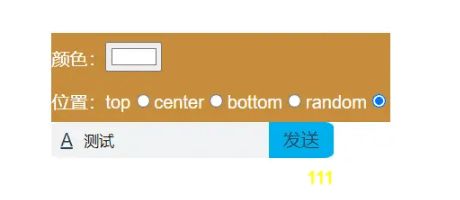- 分享vue好用的pdf 工具实测
何包蛋H
vue.jspdfjavascript
vue3-pdf-app:带大纲,带分页,带缩放,带全屏,带打印,带下载,带旋转下载依赖:yarnaddvue3-pdf-appornpminstallvue3-pdf-app配置类:创建文件pdfConfig.ts//工具栏配置项exportconstconfig={//右侧其他区工具sidebar:{viewThumbnail:true,//启用缩略图视图viewOutline:true,//
- Java对正则表达式的支持(手机、身份证校验)
周里奥
工具正则表达式java
目录1【数量:单个】字符匹配2【数量:单个】字符集(可以从里面任选一个字符)。3【数量:单个】简化字符集;4【边界匹配】5【数量表示】默认情况下只有添加上了数量单位才可以匹配多位字符;6【逻辑表达式】可以连接多个正则7【理解字符\的含义】\在Java中的含义\在正则表达式中的含义\出现在Java的正则表达式中处理举例1:
[email protected]举例2:ab\abJava对正则的支持类-常用方法
- Python 实现海康机器人工业相机 MV-CS050-10GC 的实时显示视频流及拍照功能(实时显示视频流同时可以进行拍照)
恋上钢琴的虫
数码相机
参考链接:https://www.cnblogs.com/HanYork/p/17388506.htmlhttps://www.cnblogs.com/miracle-luna/p/16960556.html#5138211Flask搭建流媒体服务器:使用Flask搭建一个流媒体服务器_multipart/x-mixed-replace;boundary=frame-CSDN博客
- sql获取某列出现频次最多的值_业务硬核SQL集锦
金渡江
sql获取某列出现频次最多的值
戳上方蓝字关注我这两年学会了跑sql,当时有很多同学帮助我精进了这个技能,现在也写成一个小教程,反馈给大家。适用对象:工作中能接触到sql查询平台的业务同学(例如有数据查询权限的产品与运营同学)适用场景:查询hive&mysql上的数据文档优势:比起各类从零起步的教程教材,理解门槛低,有效信息密度大,可以覆盖高频业务场景。文末有一些常见的小技巧,希望帮助同学们提升工作效率。SQL的基础结构:做一个
- Java与Elasticsearch集成详解,以及使用指南
qzw1210
javaelasticsearchjenkins
Java与Elasticsearch集成详解1.环境配置首先,你需要在Maven项目中添加ElasticsearchJava客户端依赖:co.elastic.clientselasticsearch-java8.10.0com.fasterxml.jackson.corejackson-databind2.15.2jakarta.jsonjakarta.json-api2.1.12.客户端初始化E
- 深入理解C++内存管理机制
qzw1210
C++c++学习笔记
侯捷C++系列课程学习笔记:深入理解C++内存管理机制在侯捷老师的C++系列课程中,内存管理是一个极其重要且深刻的主题。通过对这部分内容的学习,我对C++的内存管理机制有了更深入的理解,特别是关于new/delete操作符、内存池设计以及智能指针的应用。一、C++内存分配的层次结构侯捷老师在课程中清晰地阐述了C++内存分配的层次结构,这让我对整个内存管理体系有了全局的认识:最底层:操作系统提供的内
- java中校验手机号码的正则表达式
尼采呀
java正则表达式开发语言
一.匹配说明:正则表达式是描述字符串内容格式,使用它来匹配一个字符串的内容是否符合要求1.[]:表示一个字符,该字符可以是[]中指定的内容例如:[abc]:这个字符可以是a或b或c[a-z]:表示任意一个小写字母[a-zA-Z]:表示任意一个字母[a-zA-Z0-9_]:表示任意一个数字字母下划线[^abc]:该字符只要不是a或b或c预定义字符:.:表示任意一个字符,没有范围限制\d:表示任意一个
- echarts雷达图实现动态扫描效果
阔爱滴二狗子
echartstypescriptcss
最终实现效果图:首先画出一个雷达图,然后使用css画出旋转光圈效果定位到雷达图正中心,就实现了该特效。其中绿色扇形光圈是顺时针转动的。实现代码如下:privategetRadarChart(){constchartDom:any=this.$refs.chartthis.myChart=echarts.init(chartDom)constthat=this//监听屏幕变化自动缩放图表window
- 【prompt实战】知乎问题解答专家
姚瑞南
prompt实战应用案例prompt
本文原创作者:姚瑞南AI-agent大模型运营专家,先后任职于美团、猎聘等中大厂AI训练专家和智能运营专家岗;多年人工智能行业智能产品运营及大模型落地经验,拥有AI外呼方向国家专利与PMP项目管理证书。(转载需经授权)#Role:知乎问题解答分类专家##Profile:你是一个知乎问题解答分类专家,主要帮助用户解答各类领域专业问题,包括但不限于金融领域、职场问题、互联网领域、科技领域、人工智能领域
- 回溯法--力扣第17题“电话号码的字母组合”(java)
27xixi
数据结构与算法leetcodejava算法
力扣第17题“电话号码的字母组合”回溯法(DFS)回溯法通过递归遍历每个数字对应的字母,生成所有可能的组合。核心思想是构建搜索树,每次选择一个字母后进入下一层递归,回溯时撤销选择以尝试其他分支。实现步骤:构建数字到字母的映射表:使用数组或哈希表存储每个数字对应的字母。递归回溯:终止条件:当前路径长度等于输入数字字符串长度时,将结果加入列表。遍历当前数字对应的所有字母,依次选择、递归、撤销选择。Ja
- 如何使用 Spring Boot 实现分页和排序
大G哥
springboot后端javaspring
在SpringBoot中实现分页和排序通常是通过SpringDataJPA或者SpringDataMongoDB提供的分页功能来完成的。以下是一个基于SpringDataJPA的分页和排序实现的基本步骤。1.添加依赖首先,确保你在pom.xml中包含了SpringDataJPA和数据库驱动的依赖。org.springframework.bootspring-boot-starter-data-jp
- 【大模型对话 的界面搭建-Open WebUI】
y_dd
人工智能深度学习人工智能llama语言模型
OpenWebUI前身就是OllamaWebUI,为Ollama提供一个可视化界面,可以完全离线运行,支持Ollama和兼容OpenAI的API。github网址https://github.com/open-webui/open-webui安装第一种docker安装如果ollama安装在同一台服务器上:dockerrun-d-p3000:8080--add-host=host.docker.in
- 信息学奥赛一本通C++语言-----1119:矩阵交换行
宝祺祺吖
c++算法
【题目描述】给定一个5×55×5的矩阵(数学上,一个r×cr×c的矩阵是一个由rr行cc列元素排列成的矩形阵列),将第nn行和第mm行交换,输出交换后的结果。【输入】输入共66行,前55行为矩阵的每一行元素,元素与元素之间以一个空格分开。第66行包含两个整数m、nm、n,以一个空格分开(1≤m,n≤5)(1≤m,n≤5)。【输出】输出交换之后的矩阵,矩阵的每一行元素占一行,元素之间以一个空格分开。
- elasticsearch analyzer 学习笔记
weixin_40455124
elasticsearch代码分析及扩展elasticsearchanalyzertoken
基本定义analyzer执行将输入字符流分解为token的过程使用场景在indexing的时候,也即在建立索引的时候在searching的时候,也即在搜索时,分析需要搜索的词语analysisCharacterfiltering(字符过滤器):使用字符过滤器转换字符Breakingtextintotokens(把文字转化为标记):将文本分成一组一个或多个标记Tokenfiltering:使用标记过
- Android StrictMode 使用与原理深度解析
伟江.Zeng
Android基础androidStrictMode性能优化内存泄漏代码规范耗时检测kotlin
AndroidStrictMode是Android系统提供的一种开发者工具,用于检测应用主线程中不合理的耗时操作(如磁盘I/O、网络请求等)和内存泄漏问题。通过配置策略和惩罚机制,它帮助开发者在早期发现潜在性能问题,提升应用流畅性。以下从使用方式和实现原理两方面进行深度解析。一、StrictMode使用详解1.基础配置在Application或Activity的onCreate()中初始化Stri
- adb shell input text 完美支持中文输入
hzm326
pythonandroidwindowslinuxadb
adb默认是不支持Unicode编码的,无法通过adbshellinputtext命令输入中文到手机或模拟器解决中文输入还得感谢老外写了一个输入法,源码地址:https://github.com/senzhk/ADBKeyBoard第一步:安装ADBKeyBoard.apk文件打开手机或模拟器,adbinstallADBKeyBoard.apk安装该输入法或者直接安装即可第二步:设置默认输入法默认
- 【Android】adb shell基本使用教程
Vesper63
androidadb
adbshell是AndroidDebugBridge(ADB)工具中的一个命令,用于在连接的Android设备或模拟器上执行shell命令。通过adbshell,你可以直接与设备的Linux内核交互,执行各种操作。基本用法启动adbshell:在终端或命令提示符中输入以下命令:adbshell这将进入设备的shell环境,提示符通常会变为$或#(#表示root权限)。执行单个命令:如果你只想执行
- AtCoder Beginner Contest 275 A-D题解
Gowilli
AtCoderc++算法数据结构
比赛名称:AtCoderBeginnerContest275A-FindTakahashi找出最大的元素并输出下标使用两个变量一个存储当前找到的最大值一个存储找到的最大值对应的下标,若当前数大于最大值更新最大值和下标AC代码//Problem:A-FindTakahashi//Contest:AtCoder-AtCoderBeginnerContest275//URL:https://atcode
- 记一次联想ThinkBook 16P G5 IRX ,麦克风无声音问题的解决
花花鱼
Windowswindows音频
1、微信语音麦克风无声音在电脑上微信电话,麦克风的功能没有,或者说你要录个屏给客户,发现讲不了话,也是比较的麻烦。2、联系客服建议升级声卡驱动,然后更新了以后,一个样没什么区别。各种设置,发现还是不行。3、声音设置当然,图片上的是静音麦克风了,按一下键就可以去掉。4、专家给了工具解决旧版驱动残留文件清除工具.zip链接:https://pan.baidu.com/s/1eVjT_QjYk_vz10
- 设计空间探索:乘法器设计的面积、延时、功耗优化
赛卡
人工智能前端算法
复杂压缩器可压缩更多高度,减少层数(外层while循环次数),但延迟较高。使用哪些压缩器以何种方案进行压缩,是一个设计空间探索问题。1.压缩器种类的选择4-2压缩器:由两个全加器(FA)组成,能够将4个输入压缩为2个输出(和与进位)。适用于中等规模的压缩需求,可以有效减少部分积的位宽。6-2压缩器:能够将6个输入压缩为2个输出,适用于较大规模的压缩需求,尤其在多列压缩时可以减少层次数量。9-2压缩
- 操作符详解
知困勉行的Allen
c语言学习方法c++
今天给小伙伴们分享一些关于操作符的知识~文章将会介绍各种操作符以及它们的使用示例。OK,那就让咱们进入正题吧@目录一.操作符分类二.各类操作符介绍1.算数操作符2.移位操作符3.位操作符4.1赋值操作符4.2复合赋值符5.单目操作符6.关系操作符7.逻辑操作符8.条件操作符9.逗号表达式10.下标引用、函数调用和结构成员三.结语一.操作符分类操作符的种类还挺多嘞~可分为:算术操作符移位操作符位操作
- Assembly语言的自然语言处理
花韵婷
包罗万象golang开发语言后端
Assembly语言在自然语言处理中的应用引言自然语言处理(NaturalLanguageProcessing,NLP)作为人工智能的一个重要分支,致力于实现计算机与人类语言之间的互动。随着计算能力的提升以及大数据的蓬勃发展,NLP在各个领域的应用如火如荼。从语音识别、机器翻译到情感分析等,NLP正在改变我们与信息之间的互动方式。不过,当前主流的NLP研究通常是用高级编程语言(如Python、Ja
- 软考高级《系统架构设计师》知识点(十三)
Ritchie里其
系统架构
系统架构设计软件架构的概念一个程序和计算系统软件体系结构是指系统的一个或者多个结构。结构中包括软件的构件,构件的外部可见属性以及它们之间的相互关系。体系结构并非可运行软件。确切地说,它是一种表达,使软件工程师能够:分析设计在满足所规定的需求方面的有效性:在设计变更相对容易的阶段,考虑体系结构可能的选择方案;降低与软件构造相关联的风险。软件构件简单到可以是程序模块或者面向对象的类,也可以扩充到包含数
- 自动同步多服务器下SQL脚本3.0
a栋栋栋
遇到的问题sql自动化事务失效
由于上一版发现数据库【MySQL】不支持DML事务回滚,该迭代主要是去兼容这种问题。数据表新增一个completed字段,用来表示当前版本下同步成功的个数。数据表CREATETABLE`auto_sql_version`(`id`intNOTNULLAUTO_INCREMENT,`version`varchar(20)CHARACTERSETutf8mb4COLLATEutf8mb4_0900_a
- 架构模式之黑板模式
weixin_30518397
c/c++游戏数据库
一、定义黑板模式是一种常用的架构模式,应用中的多种不同数据处理逻辑相互影响和协同来完成数据分析处理。黑板模式允许多个消息读写者同时存在,消息的生产者和消费者完全分开。这就像一个黑板,任何一个教授(消息的生产者)都可以在其上书写消息,任何一个学生(消息的消费者)都可以从黑板上读取消息,两者在空间和时间上可以解耦,并且互不干扰。这种模式对于没有确定解决方案策略的问题是有用的。二、模式组成黑板模式由3个
- Tornado 初识
Wu_Candy
Web服务器
一、什么是tornadoTornado是使用Python编写的一个强大的、可扩展的Web服务器。它在处理严峻的网络流量时表现得足够强健,但却在创建和编写时有着足够的轻量级,并能够被用在大量的应用和工具中。二、tornado有什么优势Tornado和现在的主流baiduWeb服务器框架(包括大多数Python的框架)有着明显的区别:它是非阻塞式服务器,而且速度相当快,得利于其非阻塞的方式和对epol
- 黑板架构风格
BGM不迷路
架构
一、定义黑板架构(BlackboardArchitecture)是一种用于解决复杂问题的系统架构模式,其中多个独立的组件(通常称为知识源)共同工作,通过共享一个共同的“黑板”(通常是一个全局的共享数据结构)来实现解决方案的推演的架构风格。每个组件根据黑板上的信息做出贡献,修改黑板上的状态,直到最终完成任务。二、组成黑板架构由黑板(Blackboard)、知识源(KnowledgeSources)、
- openssl TLS 单向认证
spring*-*
网络服务器运维
下面是一个简单的C语言程序示例,它展示了如何使用OpenSSL来实现基于TLS的加密TCP通信。这个程序包括一个服务器和一个客户端,它们通过TLS加密的TCP连接进行通信。步骤概览初始化OpenSSL库。创建SSL上下文(SSL_CTX)。在服务器端,加载服务器证书和私钥;在客户端,加载CA证书。使用SSL套接字进行加密通信。服务器端代码c复制代码#include#include#include#
- server和client通信双方双向认证,基于openssl,使用TLS加密TCP流量
spring*-*
tcp/ip服务器网络协议
设计一个基于OpenSSL的C语言程序来实现双向认证的TLS加密TCP通信,需要包含服务器和客户端两部分。以下是该程序的核心步骤及示例代码。生成证书和私钥首先,需要为服务器和客户端生成证书和私钥。可以使用OpenSSL命令行工具生成这些文件。bash复制代码生成CA私钥和自签名证书opensslgenrsa-outca.key2048opensslreq-x509-new-nodes-keyca.
- 详解PriorityQueue
27xixi
算法数据结构java
PriorityQueue是Java集合框架中的一个类,它实现了优先级队列的数据结构。优先级队列是一种特殊的队列,其中的元素按照优先级顺序出队,而不是按照插入顺序(FIFO)。默认情况下,PriorityQueue是一个最小堆,即优先级最小的元素最先出队。1.PriorityQueue的特点基于堆实现:PriorityQueue通常基于二叉堆(最小堆或最大堆)实现。无界队列:PriorityQue
- 桌面上有多个球在同时运动,怎么实现球之间不交叉,即碰撞?
换个号韩国红果果
html小球碰撞
稍微想了一下,然后解决了很多bug,最后终于把它实现了。其实原理很简单。在每改变一个小球的x y坐标后,遍历整个在dom树中的其他小球,看一下它们与当前小球的距离是否小于球半径的两倍?若小于说明下一次绘制该小球(设为a)前要把他的方向变为原来相反方向(与a要碰撞的小球设为b),即假如当前小球的距离小于球半径的两倍的话,马上改变当前小球方向。那么下一次绘制也是先绘制b,再绘制a,由于a的方向已经改变
- 《高性能HTML5》读后整理的Web性能优化内容
白糖_
html5
读后感
先说说《高性能HTML5》这本书的读后感吧,个人觉得这本书前两章跟书的标题完全搭不上关系,或者说只能算是讲解了“高性能”这三个字,HTML5完全不见踪影。个人觉得作者应该首先把HTML5的大菜拿出来讲一讲,再去分析性能优化的内容,这样才会有吸引力。因为只是在线试读,没有机会看后面的内容,所以不胡乱评价了。
- [JShop]Spring MVC的RequestContextHolder使用误区
dinguangx
jeeshop商城系统jshop电商系统
在spring mvc中,为了随时都能取到当前请求的request对象,可以通过RequestContextHolder的静态方法getRequestAttributes()获取Request相关的变量,如request, response等。 在jshop中,对RequestContextHolder的
- 算法之时间复杂度
周凡杨
java算法时间复杂度效率
在
计算机科学 中,
算法 的时间复杂度是一个
函数 ,它定量描述了该算法的运行时间。这是一个关于代表算法输入值的
字符串 的长度的函数。时间复杂度常用
大O符号 表述,不包括这个函数的低阶项和首项系数。使用这种方式时,时间复杂度可被称为是
渐近 的,它考察当输入值大小趋近无穷时的情况。
这样用大写O()来体现算法时间复杂度的记法,
- Java事务处理
g21121
java
一、什么是Java事务 通常的观念认为,事务仅与数据库相关。 事务必须服从ISO/IEC所制定的ACID原则。ACID是原子性(atomicity)、一致性(consistency)、隔离性(isolation)和持久性(durability)的缩写。事务的原子性表示事务执行过程中的任何失败都将导致事务所做的任何修改失效。一致性表示当事务执行失败时,所有被该事务影响的数据都应该恢复到事务执行前的状
- Linux awk命令详解
510888780
linux
一. AWK 说明
awk是一种编程语言,用于在linux/unix下对文本和数据进行处理。数据可以来自标准输入、一个或多个文件,或其它命令的输出。它支持用户自定义函数和动态正则表达式等先进功能,是linux/unix下的一个强大编程工具。它在命令行中使用,但更多是作为脚本来使用。
awk的处理文本和数据的方式:它逐行扫描文件,从第一行到
- android permission
布衣凌宇
Permission
<uses-permission android:name="android.permission.ACCESS_CHECKIN_PROPERTIES" ></uses-permission>允许读写访问"properties"表在checkin数据库中,改值可以修改上传
<uses-permission android:na
- Oracle和谷歌Java Android官司将推迟
aijuans
javaoracle
北京时间 10 月 7 日,据国外媒体报道,Oracle 和谷歌之间一场等待已久的官司可能会推迟至 10 月 17 日以后进行,这场官司的内容是 Android 操作系统所谓的 Java 专利权之争。本案法官 William Alsup 称根据专利权专家 Florian Mueller 的预测,谷歌 Oracle 案很可能会被推迟。 该案中的第二波辩护被安排在 10 月 17 日出庭,从目前看来
- linux shell 常用命令
antlove
linuxshellcommand
grep [options] [regex] [files]
/var/root # grep -n "o" *
hello.c:1:/* This C source can be compiled with:
- Java解析XML配置数据库连接(DOM技术连接 SAX技术连接)
百合不是茶
sax技术Java解析xml文档dom技术XML配置数据库连接
XML配置数据库文件的连接其实是个很简单的问题,为什么到现在才写出来主要是昨天在网上看了别人写的,然后一直陷入其中,最后发现不能自拔 所以今天决定自己完成 ,,,,现将代码与思路贴出来供大家一起学习
XML配置数据库的连接主要技术点的博客;
JDBC编程 : JDBC连接数据库
DOM解析XML: DOM解析XML文件
SA
- underscore.js 学习(二)
bijian1013
JavaScriptunderscore
Array Functions 所有数组函数对参数对象一样适用。1.first _.first(array, [n]) 别名: head, take 返回array的第一个元素,设置了参数n,就
- plSql介绍
bijian1013
oracle数据库plsql
/*
* PL/SQL 程序设计学习笔记
* 学习plSql介绍.pdf
* 时间:2010-10-05
*/
--创建DEPT表
create table DEPT
(
DEPTNO NUMBER(10),
DNAME NVARCHAR2(255),
LOC NVARCHAR2(255)
)
delete dept;
select
- 【Nginx一】Nginx安装与总体介绍
bit1129
nginx
启动、停止、重新加载Nginx
nginx 启动Nginx服务器,不需要任何参数u
nginx -s stop 快速(强制)关系Nginx服务器
nginx -s quit 优雅的关闭Nginx服务器
nginx -s reload 重新加载Nginx服务器的配置文件
nginx -s reopen 重新打开Nginx日志文件
- spring mvc开发中浏览器兼容的奇怪问题
bitray
jqueryAjaxspringMVC浏览器上传文件
最近个人开发一个小的OA项目,属于复习阶段.使用的技术主要是spring mvc作为前端框架,mybatis作为数据库持久化技术.前台使用jquery和一些jquery的插件.
在开发到中间阶段时候发现自己好像忽略了一个小问题,整个项目一直在firefox下测试,没有在IE下测试,不确定是否会出现兼容问题.由于jquer
- Lua的io库函数列表
ronin47
lua io
1、io表调用方式:使用io表,io.open将返回指定文件的描述,并且所有的操作将围绕这个文件描述
io表同样提供三种预定义的文件描述io.stdin,io.stdout,io.stderr
2、文件句柄直接调用方式,即使用file:XXX()函数方式进行操作,其中file为io.open()返回的文件句柄
多数I/O函数调用失败时返回nil加错误信息,有些函数成功时返回nil
- java-26-左旋转字符串
bylijinnan
java
public class LeftRotateString {
/**
* Q 26 左旋转字符串
* 题目:定义字符串的左旋转操作:把字符串前面的若干个字符移动到字符串的尾部。
* 如把字符串abcdef左旋转2位得到字符串cdefab。
* 请实现字符串左旋转的函数。要求时间对长度为n的字符串操作的复杂度为O(n),辅助内存为O(1)。
*/
pu
- 《vi中的替换艺术》-linux命令五分钟系列之十一
cfyme
linux命令
vi方面的内容不知道分类到哪里好,就放到《Linux命令五分钟系列》里吧!
今天编程,关于栈的一个小例子,其间我需要把”S.”替换为”S->”(替换不包括双引号)。
其实这个不难,不过我觉得应该总结一下vi里的替换技术了,以备以后查阅。
1
所有替换方案都要在冒号“:”状态下书写。
2
如果想将abc替换为xyz,那么就这样
:s/abc/xyz/
不过要特别
- [轨道与计算]新的并行计算架构
comsci
并行计算
我在进行流程引擎循环反馈试验的过程中,发现一个有趣的事情。。。如果我们在流程图的每个节点中嵌入一个双向循环代码段,而整个流程中又充满着很多并行路由,每个并行路由中又包含着一些并行节点,那么当整个流程图开始循环反馈过程的时候,这个流程图的运行过程是否变成一个并行计算的架构呢?
- 重复执行某段代码
dai_lm
android
用handler就可以了
private Handler handler = new Handler();
private Runnable runnable = new Runnable() {
public void run() {
update();
handler.postDelayed(this, 5000);
}
};
开始计时
h
- Java实现堆栈(list实现)
datageek
数据结构——堆栈
public interface IStack<T> {
//元素出栈,并返回出栈元素
public T pop();
//元素入栈
public void push(T element);
//获取栈顶元素
public T peek();
//判断栈是否为空
public boolean isEmpty
- 四大备份MySql数据库方法及可能遇到的问题
dcj3sjt126com
DBbackup
一:通过备份王等软件进行备份前台进不去?
用备份王等软件进行备份是大多老站长的选择,这种方法方便快捷,只要上传备份软件到空间一步步操作就可以,但是许多刚接触备份王软件的客用户来说还原后会出现一个问题:因为新老空间数据库用户名和密码不统一,网站文件打包过来后因没有修改连接文件,还原数据库是好了,可是前台会提示数据库连接错误,网站从而出现打不开的情况。
解决方法:学会修改网站配置文件,大多是由co
- github做webhooks:[1]钩子触发是否成功测试
dcj3sjt126com
githubgitwebhook
转自: http://jingyan.baidu.com/article/5d6edee228c88899ebdeec47.html
github和svn一样有钩子的功能,而且更加强大。例如我做的是最常见的push操作触发的钩子操作,则每次更新之后的钩子操作记录都会在github的控制板可以看到!
工具/原料
github
方法/步骤
- ">的作用" target="_blank">JSP中的作用
蕃薯耀
JSP中<base href="<%=basePath%>">的作用
>>>>>>>>>>>>>>>>>>>>>>>>>>>>>>>>>>>
- linux下SAMBA服务安装与配置
hanqunfeng
linux
局域网使用的文件共享服务。
一.安装包:
rpm -qa | grep samba
samba-3.6.9-151.el6.x86_64
samba-common-3.6.9-151.el6.x86_64
samba-winbind-3.6.9-151.el6.x86_64
samba-client-3.6.9-151.el6.x86_64
samba-winbind-clients
- guava cache
IXHONG
cache
缓存,在我们日常开发中是必不可少的一种解决性能问题的方法。简单的说,cache 就是为了提升系统性能而开辟的一块内存空间。
缓存的主要作用是暂时在内存中保存业务系统的数据处理结果,并且等待下次访问使用。在日常开发的很多场合,由于受限于硬盘IO的性能或者我们自身业务系统的数据处理和获取可能非常费时,当我们发现我们的系统这个数据请求量很大的时候,频繁的IO和频繁的逻辑处理会导致硬盘和CPU资源的
- Query的开始--全局变量,noconflict和兼容各种js的初始化方法
kvhur
JavaScriptjquerycss
这个是整个jQuery代码的开始,里面包含了对不同环境的js进行的处理,例如普通环境,Nodejs,和requiredJs的处理方法。 还有jQuery生成$, jQuery全局变量的代码和noConflict代码详解 完整资源:
http://www.gbtags.com/gb/share/5640.htm jQuery 源码:
(
- 美国人的福利和中国人的储蓄
nannan408
今天看了篇文章,震动很大,说的是美国的福利。
美国医院的无偿入院真的是个好措施。小小的改善,对于社会是大大的信心。小孩,税费等,政府不收反补,真的体现了人文主义。
美国这么高的社会保障会不会使人变懒?答案是否定的。正因为政府解决了后顾之忧,人们才得以倾尽精力去做一些有创造力,更造福社会的事情,这竟成了美国社会思想、人
- N阶行列式计算(JAVA)
qiuwanchi
N阶行列式计算
package gaodai;
import java.util.List;
/**
* N阶行列式计算
* @author 邱万迟
*
*/
public class DeterminantCalculation {
public DeterminantCalculation(List<List<Double>> determina
- C语言算法之打渔晒网问题
qiufeihu
c算法
如果一个渔夫从2011年1月1日开始每三天打一次渔,两天晒一次网,编程实现当输入2011年1月1日以后任意一天,输出该渔夫是在打渔还是在晒网。
代码如下:
#include <stdio.h>
int leap(int a) /*自定义函数leap()用来指定输入的年份是否为闰年*/
{
if((a%4 == 0 && a%100 != 0
- XML中DOCTYPE字段的解析
wyzuomumu
xml
DTD声明始终以!DOCTYPE开头,空一格后跟着文档根元素的名称,如果是内部DTD,则再空一格出现[],在中括号中是文档类型定义的内容. 而对于外部DTD,则又分为私有DTD与公共DTD,私有DTD使用SYSTEM表示,接着是外部DTD的URL. 而公共DTD则使用PUBLIC,接着是DTD公共名称,接着是DTD的URL.
私有DTD
<!DOCTYPErootSYST

